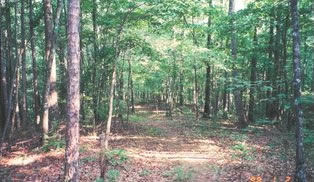
Natural Burial
On a family trip back from the Georgia coast in the summer of 2003, I stopped off in the tiny town of Westminster, South Carolina (pop. 2,000), to see the Ramsey Creek Preserve for myself.
Sitting in the shadow of the Blue Ridge Mountains, not far from the Georgia border, Ramsey Creek is the first -- and at that time only -- "natural" cemetery in the United States. On this thirty-plus acre woodland, heavily forested with mostly yellow and shortleaf pine, the dead are buried in simple graves, interred in either cloth shrouds or plain coffins made from cardboard or plentiful pine. Vaults are banned, embalming prohibited. The idea, so at odds with modern burial, is to allow the body to re-join the elements, to perpetuate the cycles of nature, to return dust to dust.
I'd read about Ramsey Creek, and knew that some 200-plus similar woodland burial grounds were scattered throughout in the U.K. I'd come to South Carolina see if the reality matched what clearly on paper promised such a compelling alternative to the excessive, costly and tired sendoff on offer at the local funeral home.

For the better part of an afternoon, I walked the rough trail that cut through the memorial preserve, and afterwards talked with its founder, Billy Campbell -- the town doctor -- and his wife and business partner, Kimberley. By the time I got back to the Greenville hotel to collect my family, I felt sure Ramsey Creek represented not only a viable "green burial" option but one resonant enough to define a new, more truly natural American Way of death.
I'd also walked into a book project. For the next two years, I traveled the country in pursuit of other burial options that, like interment at Ramsey Creek, returned remains to the elements, were sparing of resources and, thus, light on the pocketbook. The result of that effort is Grave Matters: A Journey Through the Modern Funeral Industry to a Natural Way of Burial, which Scribner will release on January 9th.
I found, and reported on, a dozen families who opted out of the standard funeral experience in favor of more natural return. For some, that meant woodland burial, cremation and burial at sea, or interring the ashes of their loved ones in concrete "memorial reefs" that were later dropped into the Atlantic to serve as habitat for aquatic life. Still other families conducted home funerals and backyard burials; one hired a local carpenter to build a plain, pine coffin. By way of contrast, I wrote a pair of opening chapters that provide a step-by-step review of the embalming process and chart the potential environmental consequences that follow from standard burial.
I had two goals. One, to inform families that they don't have to submit to the strictures of the modern funeral when death comes calling (i.e., embalming is almost never required). And, two, to offer a picture of the many more truly natural alternatives that exist and then show how to access them.
I hope this blog will serve as a useful companion to the book. I'll use this space to report on developments in the field of natural burial, share ideas and engage in discussion. I welcome your participation.
Mark Harris
1 comment:
It is a priviledge to me the first blog on the Grave Matters blog. Our company had the pleasure of working with Mark as he researched his topic. Eternal Reefs allows the families to participate in creating their loved one's Memorial Reef. He interviewed our families during a very personal and intimate time as he followed them through the casting, viewing, placement and final dedication of the Memorial Reef. He involved himself with the families with a professional and compansionate manner. Our families enjoyed his presence and they are all looking forward to the release of his book "Grave Matters". We are proud to have worked with him and look forward to his next project.
Post a Comment